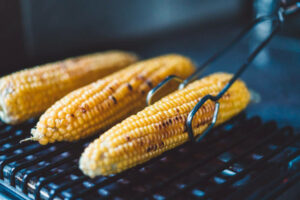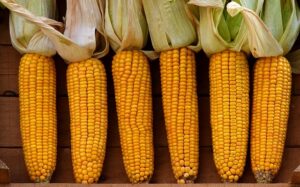Corn-on-the-Cob
go.ncsu.edu/readext?1019334
en Español / em Português
El inglés es el idioma de control de esta página. En la medida en que haya algún conflicto entre la traducción al inglés y la traducción, el inglés prevalece.
Al hacer clic en el enlace de traducción se activa un servicio de traducción gratuito para convertir la página al español. Al igual que con cualquier traducción por Internet, la conversión no es sensible al contexto y puede que no traduzca el texto en su significado original. NC State Extension no garantiza la exactitud del texto traducido. Por favor, tenga en cuenta que algunas aplicaciones y/o servicios pueden no funcionar como se espera cuando se traducen.
Português
Inglês é o idioma de controle desta página. Na medida que haja algum conflito entre o texto original em Inglês e a tradução, o Inglês prevalece.
Ao clicar no link de tradução, um serviço gratuito de tradução será ativado para converter a página para o Português. Como em qualquer tradução pela internet, a conversão não é sensivel ao contexto e pode não ocorrer a tradução para o significado orginal. O serviço de Extensão da Carolina do Norte (NC State Extension) não garante a exatidão do texto traduzido. Por favor, observe que algumas funções ou serviços podem não funcionar como esperado após a tradução.
English
English is the controlling language of this page. To the extent there is any conflict between the English text and the translation, English controls.
Clicking on the translation link activates a free translation service to convert the page to Spanish. As with any Internet translation, the conversion is not context-sensitive and may not translate the text to its original meaning. NC State Extension does not guarantee the accuracy of the translated text. Please note that some applications and/or services may not function as expected when translated.
Collapse ▲Don’t you love this time of year when we can get local fresh corn-on-the-cob? Yum. I
just stopped by a roadside market an grabbed a dozen.
Here are some tips of selecting, storing and preparing this fabulous summer treat.
Purchasing: Many farm stands don’t want you to pull the husks down when picking out your corn. That’s OK. Keeping the husks on keeps the corn fresh. Select firm ears that have bright green husks. This husk should fit snugly around the ears of corn.
Immature corn will have blond tassels, and mature ears will have dark brown tassels.
You want plenty of visible silk. You can feel each ear gently through the husk without
peeling it to check for even, plump kernels.
Storing: Get corn as quickly from the farm or market to the table. After only a few hours at room temperature, sugars can turn to starch, causing loss of flavor and overall sweetness. Corn can be stored with the husks on or off. Either way, keep it tightly secured in plastic wrap or a plastic bag in the refrigerator until ready to cook. For best results use within 4 days. Raw corn cut off the ears will last only a day or two in the refrigerator before turning sour. Cooked corn that is cut off the ears will last in the refrigerator about 4 to 5 days.
Preserving: Corn can be safely and successfully preserved for longer term storage.
Check out the National Center for Home Food Preservation (http://nchfp.uga.edu) for
instructions. Corn can be frozen on or off the cob and it also can be preserved through pressure canning.
Cooking: The time-honored way to cook corn-on-the cob is in boiling water on top of
the stove. Fill large pot with enough water to cover the ears of corn you will be boiling. Bring to a boil, before placing your shucked corn in the pot of water. Cover pot and reduce to medium. Cook corn until the kernels are tender about 6 to 8 minutes or until desired tenderness. Some old family recipes add sugar to the water to sweeten the corn. This isn’t necessary. DON’T add salt to the water as this will toughen the corn.
 Grilling: This can be a fun way to change up your traditional corn on-the cob. The
Grilling: This can be a fun way to change up your traditional corn on-the cob. The
important question with this method is whether to grill the corn in the husk or shucked. Leaving the shucks on will help retain moisture and flavor. But there is always a risk of burns because you’re handing hot husks
Un-shucked- Pull the husks back and remove all of the silk but do not pull the husk off the base of the corn. Look for unwanted critters, too, then pull the husks back up over the corn. Soak ears with the husks in cold water 30-60 minutes. Grill the corn on a hot preheated grill for 15 minutes or until tender, turning ears frequently. Stay close to the grill as there may be potential flare ups when the husks begin to dry out.
Shucked-Place each ear of shucked corn on a piece of aluminum foil. Add flavorings and seasoning before sealing the foil. Grill for about 15-20 minutes.
Common condiments and seasonings for corn-on-the-cob include butter, salt, and black pepper. But you don’t have to stick to that! The flavor of corn goes great with basil, chili or chipotle powder, oregano or rosemary. A popular recipe is for Elotes or Mexican Street Corn which covers the cooked corn on-the-cob with mayonnaise, sour cream, crema or yogurt and then tops with chili powder, cheese, cilantro and lime. Be creative and experiment with different flavor combinations!
Sources: University of Nebraska Lincoln Extension, University of Wyoming Extension, Perdue University Extension; Iowa State University Extension
Syracuse is a Family and Consumer Science team member and can be reached at N.C. Cooperative Extension, Brunswick County Center 910-253-2610 or by email at
clsyracu@ncsu.edu




